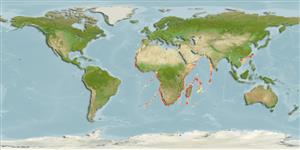Common names from other countries
Ελασμοβράγχιοι (καρχαρίες και σαλάχια) (sharks and rays) >
Squaliformes (Sleeper and dogfish sharks) >
Centrophoridae (Gulper sharks)
Etymology: Centrophorus: centr[um] (L.), prickle or sharp point; phorus, from phoreus (Gr.), bearer or carrier, referring to grooved spines on dorsal fins. (See ETYFish); lusitanicus: -icus, belonging to: Lusitania, ancient name of Portugal, type locality (although identity of holotype is in dispute, treated as a junior synonym of C. granulosus by some workers). (See ETYFish).
Issue
Portugal and so must be considered a junior synonym of the latter species. The purported syntype BMNH 1867.7.23.2 is not a type specimen and refers to a separate long-finned species (see Ref. 116740 for available evidence).
Environment: milieu / climate zone / depth range / distribution range
Οικολογία
Θαλασσινό(ά) βαθύβιο(ς); εύρος βάθους 300 - 1400 m (Ref. 247). Deep-water; 43°N - 38°S, 18°W - 124°E (Ref. 54312)
Eastern Atlantic: Portugal, Senegal, Côte d'Ivoire to Nigeria. Western Indian Ocean: southern Mozambique and possibly Natal, South Africa (Ref. 11228). Western Pacific: China (Ref. 6577) and Taiwan (Ref. 247); occurrence in the Western Central Pacific uncertain but should be watched for (Ref. 31367). Often confused with Centrophorus niaukang and Centrophorus granulosus (Ref. 31367).
Length at first maturity / Μέγεθος / Βάρος / Age
Maturity: Lm 116.0, range 88 - 144 cm
Max length : 160 cm TL αρσενικό/απροσδιόριστο; (Ref. 5578)
Ραχιαίες άκανθες (συνολικά): 2; Μαλακές ραχιαίες ακτίνες (συνολικά): 0; Εδρικές άκανθες 0; Μαλακές εδρικές ακτίνες: 0. A large, stout gulper shark with a broad snout, a long, low 1st dorsal fin and a high 2nd dorsal fin; pectoral rear tips moderately long; denticles low, flat and smooth (Ref. 5578). Pearl-grey in color (Ref. 5578).
A large deepwater dogfish of the outer continental shelves and upper slopes (Ref. 247). Feeds on bony fish, small dogfish sharks, squids, and lobsters (Ref. 247). Ovoviviparous (Ref. 50449). Utilized as food fish and as fishmeal (Ref. 247).
Ovoviviparous, embryos feed solely on yolk (Ref. 50449). Number of young 1 to 6 per litter; size at birth 33-36 cm TL (Ref. 247, Ref. 58048). Distinct pairing with embrace (Ref. 205).
Compagno, L.J.V., 1984. FAO Species Catalogue. Vol. 4. Sharks of the world. An annotated and illustrated catalogue of shark species known to date. Part 1 - Hexanchiformes to Lamniformes. FAO Fish. Synop. 125(4/1):1-249. Rome, FAO. (Ref. 247)
IUCN Red List Status (Ref. 130435)
CITES (Ref. 128078)
Not Evaluated
Threat to humans
Harmless
Human uses
αλιεία: περιορισμένης εμπορικότητας
Περισσότερες πληροφορίες
ΑναφορέςΥδατοκαλλιέργειεςΠροφίλ υδατοκαλλιέργειαςΣτελέχοιΓενετικήElectrophoresesΚληρονομικότηταΑσθένειεςΜεταποίησηMass conversion
ΣυνεργάτεςΦωτογραφίεςStamps, Coins Misc.ΉχοιΣιγκουατέραΤαχύτηταΚολυμβητικός ΤύποςΕπιφάνεια βραγχίωνOtolithsΕγκέφαλοιΌραση
Εργαλεία
Special reports
Download XML
Διαδικτυακές πηγές
Estimates based on models
Preferred temperature (Ref.
115969): 5.3 - 12, mean 9 (based on 147 cells).
Phylogenetic diversity index (Ref.
82804): PD
50 = 0.5001 [Uniqueness, from 0.5 = low to 2.0 = high].
Bayesian length-weight: a=0.00263 (0.00121 - 0.00572), b=3.18 (2.99 - 3.37), in cm Total Length, based on LWR estimates for this (Sub)family-body shape (Ref.
93245).
Τροφικό Επίπεδο (Ref.
69278): 4.4 ±0.63 se; based on food items.
Ελαστικότητα (Ref.
120179): Πολύ χαμηλό, ελάχιστος χρόνος για διπλασιασμό πληθυσμού > 14 έτη (Fec=1).
Fishing Vulnerability (Ref.
59153): Very high vulnerability (90 of 100).
Climate Vulnerability (Ref.
125649): Moderate to high vulnerability (54 of 100).
